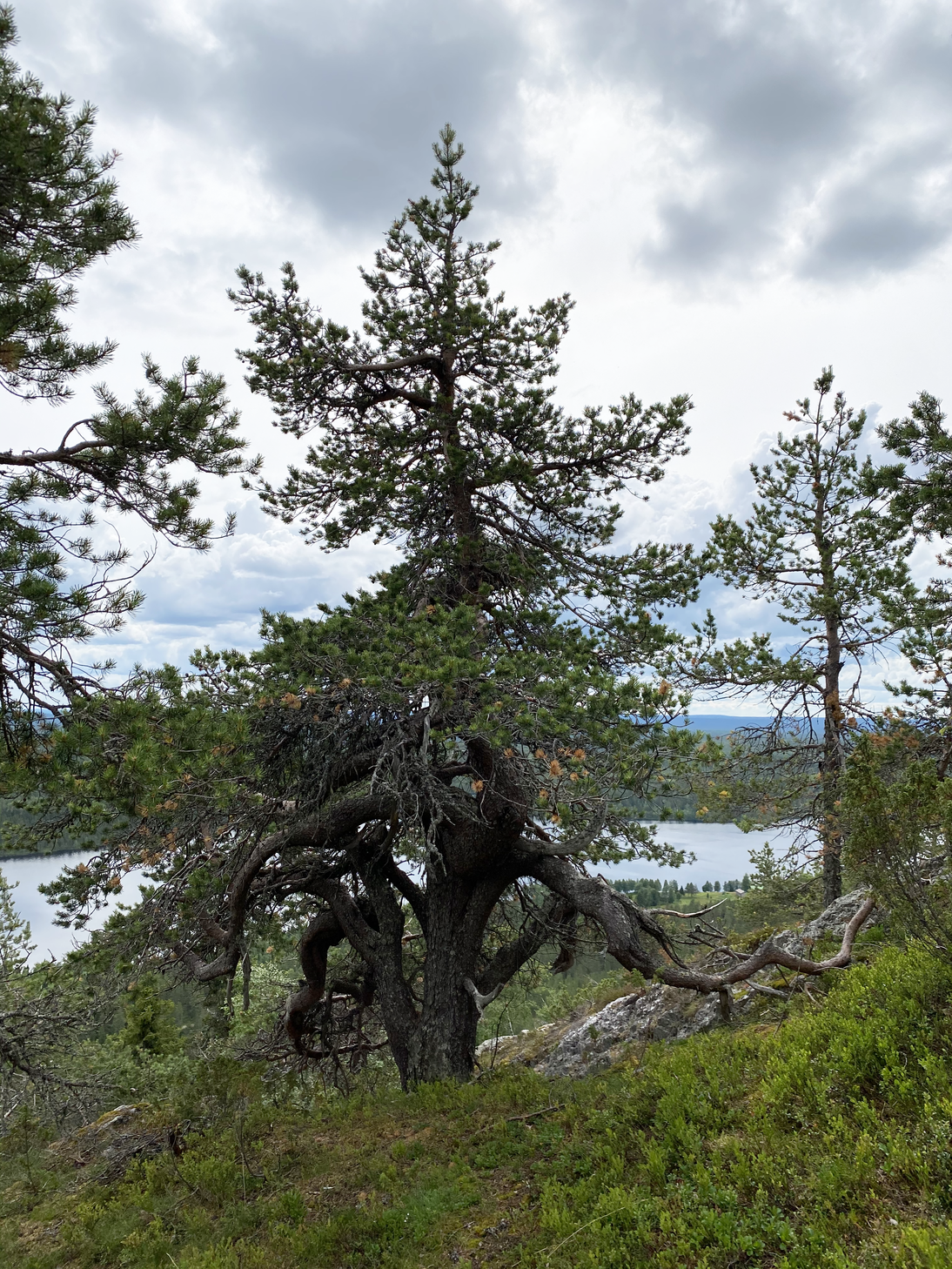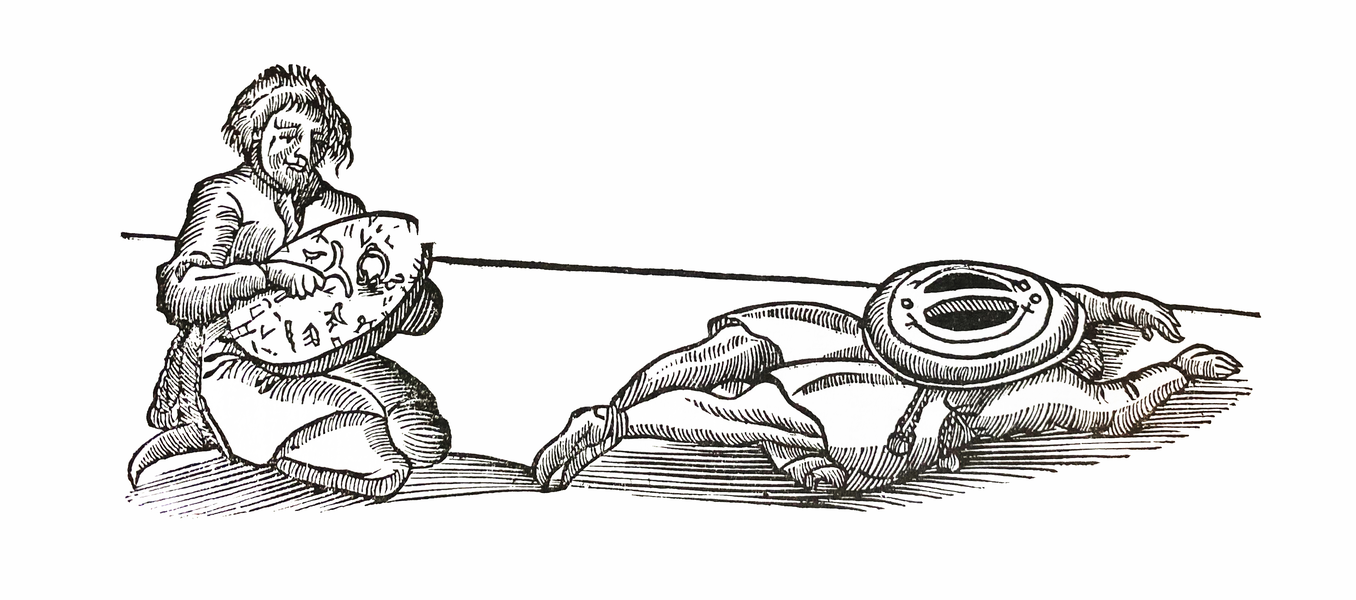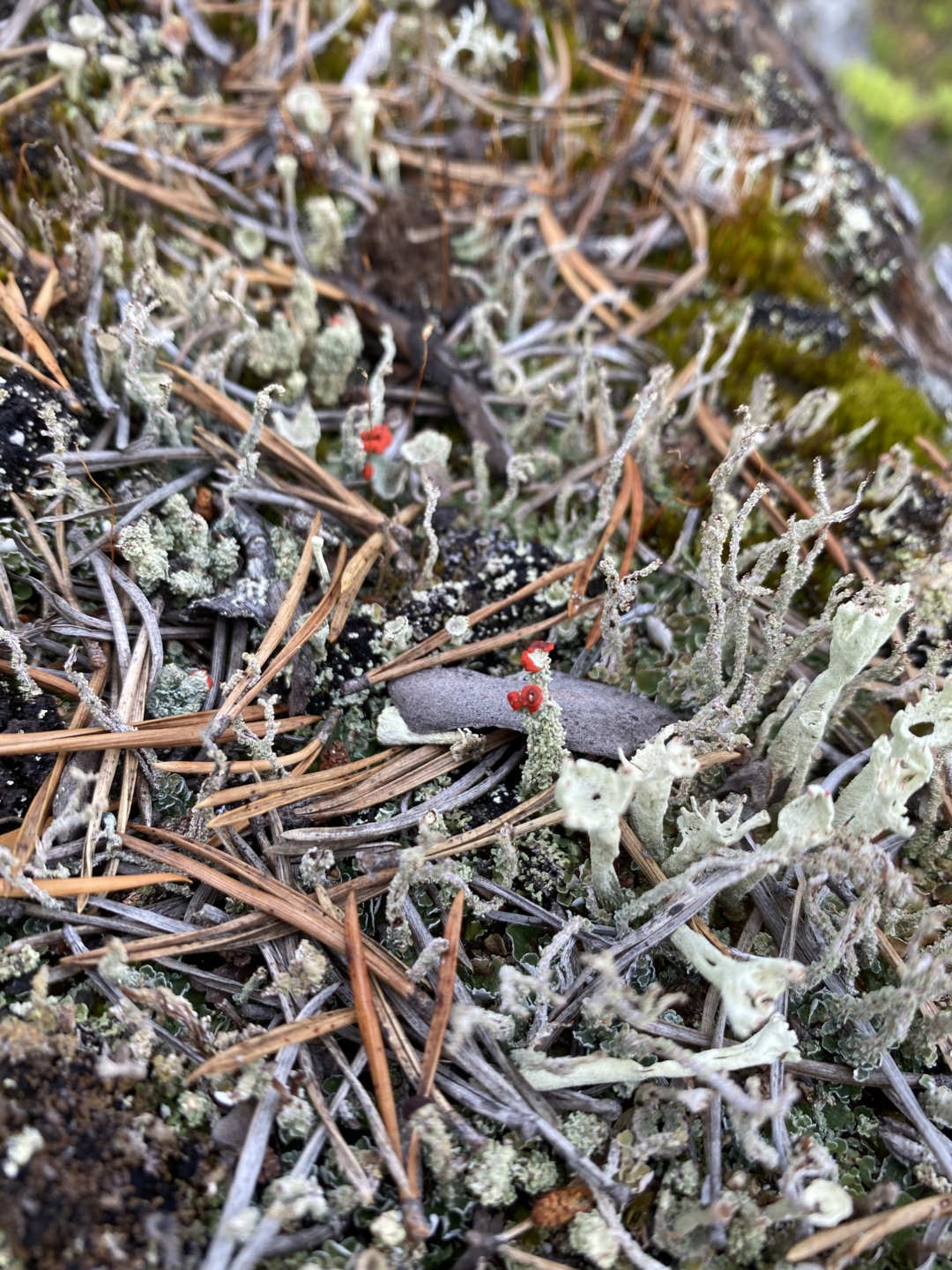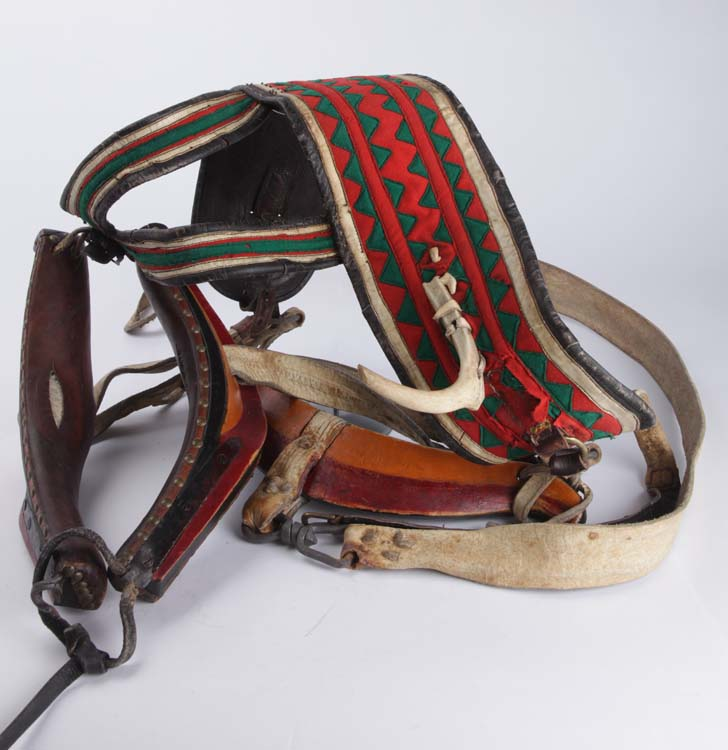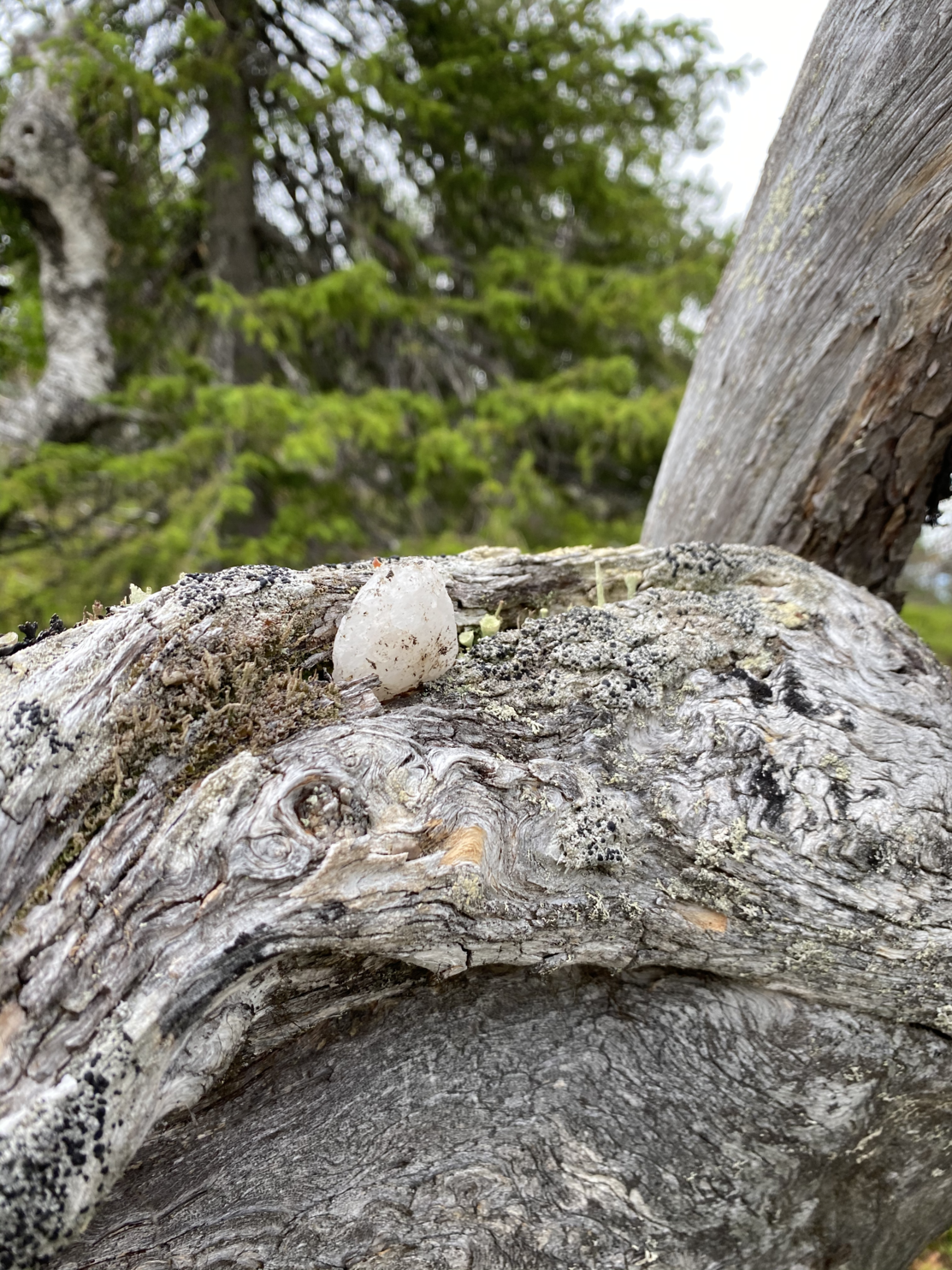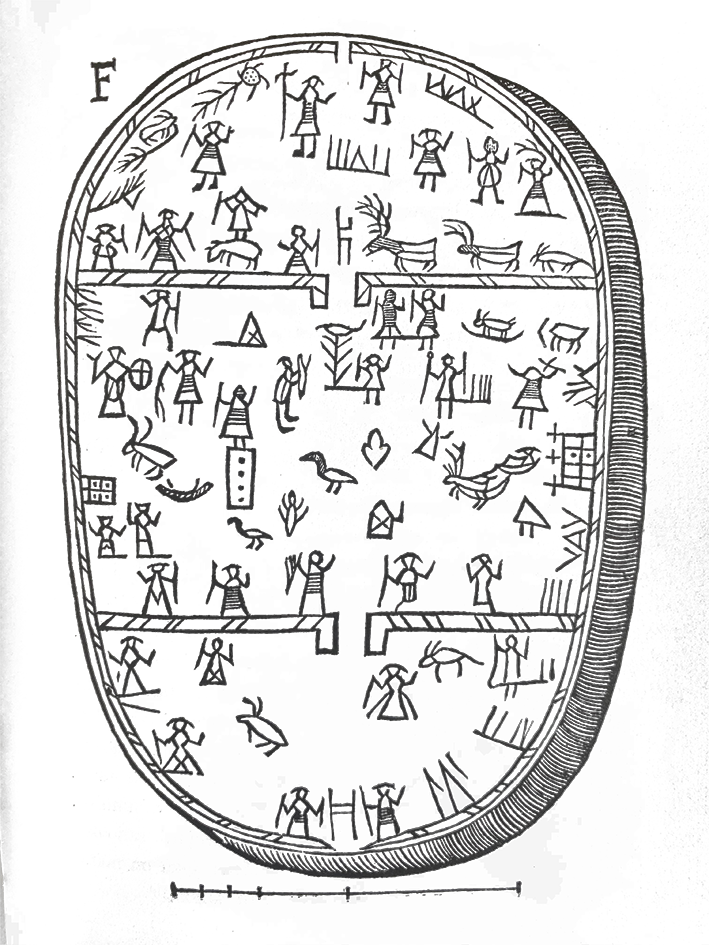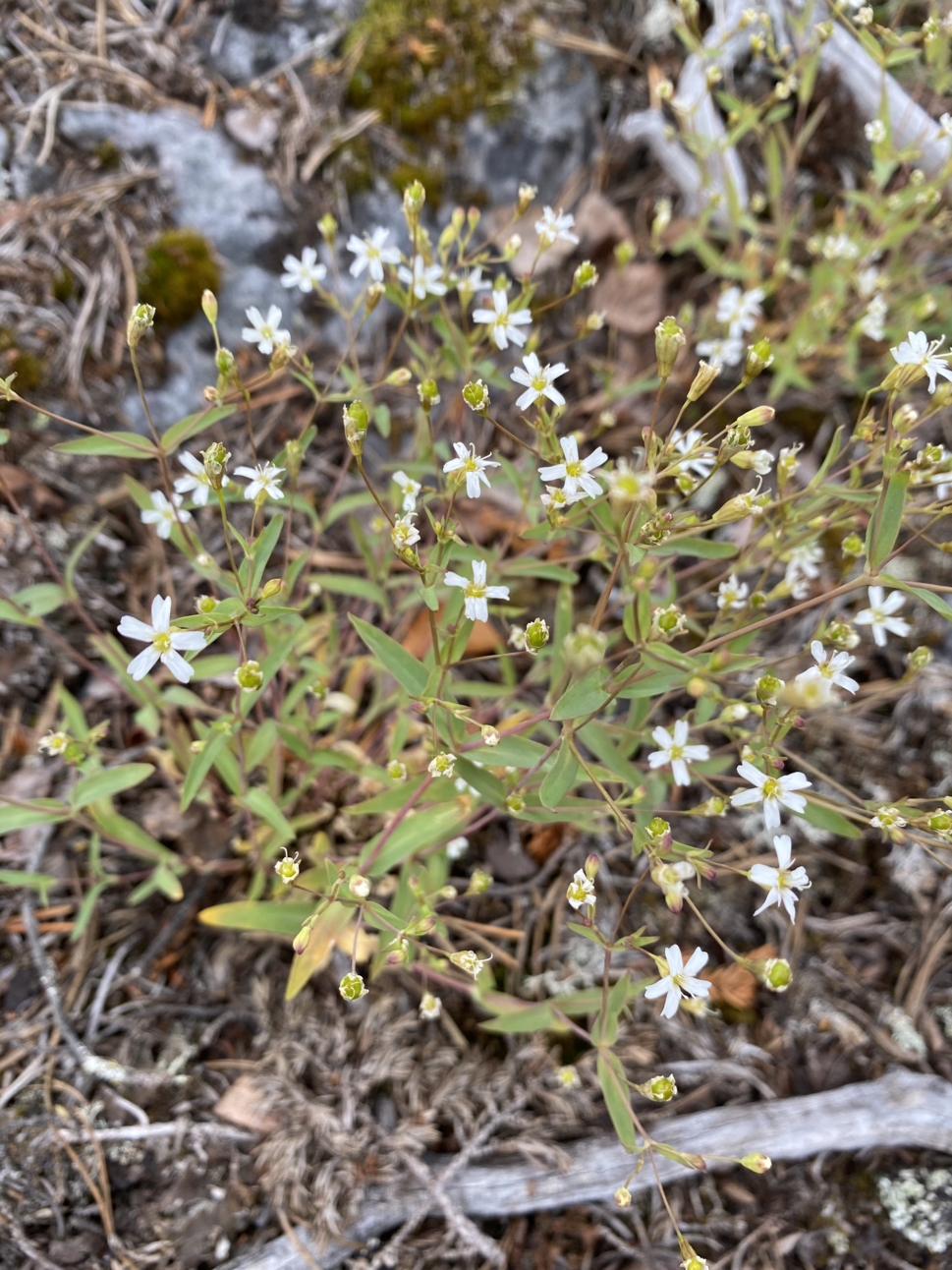I’m standing on the top of the Pyhävaara holy hill. This used to be the holy site for the Sámi called a Seita. The top of the hill had a stone structure that was pushed down from the hill in the 19th century by a military officer. A similar stone structure can still be found at the top of the Nuorunen fjeld on the Russian side of the border in an area that used to belong to Kuusamo. Now the top of the Pyhävaara is mostly bare, only a structure left is the more contemporary stone structure set up by visitors. There is also all sorts of trash: glass, cigarette butts, remains of plastic wraps and remains of a wooden structure probably done during or after the WW2. I clean up the place for awhile and take the trash with me. I leave behind bread for the birds and the other critters to eat. As I climb down the hill side I find an endangered plant species Gypsophila fastigiata (Kangasraunikki).
I still find it difficult to comprehend the multiple different ethnic, cultural and national backgrounds of myself. My family from my mother’s side is the priests, the overfishing and forest burning Finnish invaders and the silenced Sámi. From my father’s side I’m very deeply Central Osthrobotnian. His family has lived in the same area since forever. Except for my great-grandfather who was born in Eveleth, Minnesota in the U.S. of A. His father was working in the railroad construction there and died in a work related accident. The mother and the children had to return back to the same area in Osthrobotnia where their family had lived forever.
My father’s mother was originally from the part of Karelia that Finland lost after WW2. She changed religion from Eastern Orthodox to Lutheran when she married my grandad. Her parents (and maybe my grandmother) most likely spoke Livvi Karelian as their native language. Livvi Karelian language is spoken in the areas between Lake Ladoga and Lake Onega in modern day Russia, The area is also known as Olonets Karelia.
The multitude of very different family backgrounds makes it difficult to relate any of them. The lost connection. Even a generation ago to my grandmother's Karelian family. I’ve got no idea what it was like! And if I try to understand these backgrounds it seems like I should dive into four very different oceans to learn again. Things that could end up terribly wrong. I might revive a Frankenstein’s monster, made up of bits of this and that.
My heritage is from three different cultural areas in Finland, but maybe that is the “Finnishness” in me: a mixture of people from many different places around this odd peninsula. In modern day Finland ethnonationalism is gaining support, and they dream of a Finnish state for only “ethnically Finnish people”. I wonder what thet would think about my background or what do they actually perceive as “ethnic Finns”? Are Karelians part of this story or any other nation part of this purebred nation?
I can light a candle at the memorial table of the dead in an Orthodox church to honor the Karelian ancestors of that past. I can visit the Lutheran graveyard during holidays and light candles on graves of my past relatives. I can visit the Pyhävaara holy hill of the Sámi in Kuusamo and clean the place from trash and spend a little time there remembering that past. I personally have lately enjoyed trying to keep up some family traditions. I don’t have to follow them religiously but I can try to maintain them gently. Try to maintain a yearly cycle of holidays and festivities to mark the changing of the seasons. While writing this I’m enjoying the darkest days of the year. For the first time in long time the darkness feels nice and comforting. I know it will pass and around christmas the amount of light will increase. A good way to remember is to celebrate.
I also feel that I can try to remember the past and tell about it to others and maybe through the stories others and the generation of my nephews and their cousins can find meaning and maybe understand a bit more about where their family came from and maybe understand a bit better their place on earth
What is left of this Sámi heritage in Kuusamo? Most visible is probably the place names in Kuusamo that are of Sámi origin. Like the village of Vuotunki where my grandfather was from. Vuotunki in Sámi meant animal foot prints or other markings possibly meaning that it was a place that had traces and markings of animals. My grandmother's home village is called Juuma and meant a small bay. There are a couple of Suorajärvi lakes in Kuusamo. In Finnish the name means a straight lake. Neither of the lakes are actually straight. The suora- part of the word that translates in Finnish as straight, but the word in Sámi refered to something like branching or curving. The Suorajärvi I have visited is rather like a curve with branches, the other one is round.
My grandparents spoke in dialect. My grandmother sometimes has a specific soft s sound. The intonation and the rhythm is unique and slightly different from the dialects closer to Oulu or Kainuu or at least I can hear a difference, I’m not sure if this is the case with other people. And like I said there used to be no d but a t.
Once we were at our family cottage with my grandparents and my grandfather returns inside and says: “Poro oli tamilastannu rannassa.” I undertsood that the reindeer had messed up the mud by the lake turning things like grass and the boat muddy. I guess my grandfather was mostly worried about his precious wooden row boat that the reindeer could have damaged while jumping around the mud. This tamilastannu word is still a question mark after a decade or two. I have tried to find the meaning for this word which I forgot to ask from my grandfather. In my mind it has always meant something like that the reindeer has been jumping around, dancing or something in the mud by the lake. I haven’t found any Finnish words resembling it. Then one day I was reading the small vocabulary of Kemi Sámi of Fellman and wasn’t really looking for anything special but for whatever reason I then got stuck to the word meaning “I’m dancing” tauttam. That is the only word I have found that even little resembles the word my grandfather used. Or maybe it originates from the Karelian spoken by people on the Russian side?
There is a fear of not fitting in or blending in and fear of being singled out that I see in Kuusamo. Of course it is a very common issue throughout Finland. Of course the church, the state and the occasionally visiting Russian army has left paranoia and insecurities in our collective minds and bodies.
But Kuusamo seems to have a specific kind of a local flavor added to it that for me seems to be connected to its own past: Kuusamo has consisted of small remote village communities where the jurisdiction and the church could come, tax and observe people living there only few times a year. The people of these communities could maybe keep forbidden behaviour hidden from the outsiders. The members of the community could silently approve many kinds of behaviour but when conflict surfaces this knowledge of forbidden behaviour could be used as a weapon. It is also maybe good to mention that because the population of these communities was very small and the environment was very difficult for farming and the Finnish lifestyle, the meaning of every single member of the community became important. You needed everyone you could get to secure the future of the community. This meant that all sorts of behaviour was accepted to a certain degree. This also ment that people would be valued by what they did for their community and family.
In my experience the people in Kuusamo (and I am sorry this feels like a huge generalization but I guess I am more talking about local habits of the people as they appear to me) can be very fiery, talkative, humoristic, affectionate and social but in public and among strangers they might appear as silent and maybe mistrustful especially to people coming from cities. I feel that it takes awhile for locals to open up. I have heard that some people who move to Kuusamo feel that they will be treated as outsiders for a very long time. For me this cautious behaviour towards strangers has great connections to the history of Kuusamo and the invasion – you could never know the motivation of the commer: the priest could talk about beautiful heavenly things but then in next turn could behave violently for reasons you might not understand – was it a word you used that was wrong or a gesture or whatever that caused it. You became slightly paranoid and worried about everything you do in the public.
A good example of a shared fear in Finland originating from many centuries ago is the ryssäviha, the hate towards Russians. Some historians trace this back to the Great Northern War when Russian army invaded and occupied Finland for 1714 until 1721. During the occupation the Russian soldiers often burned villages, looted, raped, killed and took slaves. This left a scar that is still present in our collective Finnish minds, that often today is seen as a form of racism.
An older man from the areas where my Karelian grandmother was from, told that they had a saying in Karelia that described the difference between the Russians and the Swedish. Both countries have historically fought over Karelia several times. The difference between the Russians and The Swedish was that the Swedish allowed people to finish their meals before killing them. But the Russians just killed everybody immediately. I guess the hate that comes from the fear of the Russians could be even older than just the 18th century.
The hate towards the past things in Kuusamo shows up in the way people there generally dislike reindeers as they come to their front yards to make a mess – and I understand completely – it must be annoying that the reindeer eat your flowers you spend time and money to maintain. The reindeer mess up traffic by standing in the middle of roads and many call the animals the most stupid animal there has ever been. My grandfather always shouted at the reindeer if they were approaching us, trying to make them go away, I didn't understand why, but maybe it was that he didn’t want them to bring mosquitoes with them, or maybe he was afraid that the reindeer could kick kids or buckets full of berries we just picked. But it is interesting how this once very important animal – the backbone of the community and supporter of life – is now seen as a nuisance and source of lot of anger. I see many connection to the way people wanted to hide the past and get rid of the old that reminds of the ugly past - in this case the reindeer being the past. People no longer have need for them as they can buy winter clothes made of synthetic fibers and buy plastic wrapped pork meat at the local Prisma hypermarket. The reindeer meat has become an expensive luxury item that people don’t eat it that often. Many locals don’t see the point in paying so much of it. It has become the delicacy for the people living elsewhere who can afford it. So the reindeer are there to remind the locals about the past and then also the luxury of eating reindeer. And then the bloody relic comes to your front yard and eats your flowers!! Piss off!!!
There are also problematic historical objects and remains. Maybe the most problematic are the remains of a Sámi witch from the Kitka Siida area that are part of the collection of the Northern Ostrobothnia Museum. The burial was found on a former island now a peninsula next to the lake Kitkajärvi in 1970. The person was buried on their back, their feet pointing towards north and their head towards south. The witch also had in the grave: a tin bird figure, a silver buckle, a knife, and a hammer of a witch's drum. The museum recently dismantled its Sámi exhibition that was built in the 90's and had its obvious problems exhibiting the past of indigenous peoples. One of the things presented there were the remains of the witch from Kitka Siida and his belongings. As many museums around the world are returning the dead and the items from their collections back to the indigenous people, so is the The Northern Ostrobothnia Museum trying to repatriate some of their possessions. It is now doing DNA testing in order to see if the remains of the witch are in fact Sámi. There are many issues around this testing, e.g. who knows what were the genetics of the Kitka Siida Sámi as there are apparently no other remains found in the area. The museum has plans to give the remains to the Sámi museum Siida in Inari if their testing finds the remains to be of Sámi offspring.
There is then the issue of the Sámi Parliament of Finland and some of the people who claim to be the offspring of the Kemi Sámi. The Sámi parliament has disputed the authenticity of the offspring. I understand the background of this argument, and will discuss this later in this text. But as the Sámi parliament of Finland doesn’t recognize the offspring of the Kemi Sámi, people are worried that the remains will be given to people who don’t have any connection to the remains and who don’t recognize them as the heritage of Kemi Sámi offspring. But then just recently the Siida museum announced that it won’t be keeping any Sámi remains found outside the official Sámi areas of the present day. The museum will give all these outsider remains to the University of Helsinki, Department of Anatomy and wish that the university will bury them in future. This most likely means that the remains of the Kitka witch are not welcome to the collections of the Sámi museum Siida. So the remains are at the moment just sitting in the warehouse of the Northern Ostrobothnia Museum. There are locals in Kuusamo who want to get the remains back to Kuusamo and buried back at the site they were found. The location is currently on the yard of a vacation cottage. I think I have heard that there is now a sauna on top of the actual location. But neither the Northern Ostrobothnia museum or the city of Kuusamo are interested in the re-burial of the remains. The remains of this apparently important person might be forgotten in the storage.
A recent “Forest Lapp” report by the Finnish government is about the people who claim to be the offspring of Kemi Sámi. The term Forest Lapp or Forest Sámi is used by many of the Kemi Sámi offspring who claim that they have been Sámi always and have never lost the connection. The Forest Lapp is also used to make a distinction between the Sámi and the Forest Lapp as the question who is Sámi is very heated at the moment. I have chosen to use the politically neutral term Kemi Sámi. And I feel I have to say again that I don’t think I’m Sámi just by having some ancestors who were, but I am still their offspring. I don’t want to say either that the people who feel that they are Sámi should be denied the possibility to be called that. I just hope this mess could be sorted out somehow or at least have a dialogue.
I have come to understand that my family's past is part of the same continuation that the present day Sámi live in – similarly as the Sámi in North Lapland and elsewhere are fighting for their survival, my ancestors fought for their rights. But my ancestors lost and they had to blend with the Finns. And knowing this makes me overwhelmingly sad, my body and mind ache, there is a sense of pain and emptiness in my chest, pain in my head and darkness in my mind, my limbs feel weak. I have cried the fate of my ancestors. And hope that the people who still have their language and culture can thrive.
The “Forest Lapp” report mentions the problem of many objects in the collections of museums that have been collected in the areas of the Kemi sámi. The objects haven’t ever been studied in light that they might have belonged to the Kemi Sámi peoples and their offspring as the people were thought to have disappeared, moved to other locations or just died. Instead they have been labeled as “generic Sámi” or “Sámi influenced”. This is obviously a big problem if we want to understand the history of Lapland and Northern Osthrobotnia. The report suggests that this material should be restudied.
I remember that there were many Sámi style objects in my childhood in Kuusamo. Of course there were the made in China tourist dolls dressed up in fake Sámi costumes and then some miniature reindeer skin shoes among others. Some of the stuff was obviously some random tourist stuff given by someone as a gift from their travels. There were so many items nodding to the direction that I can’t remember exactly what everything my grandparents had. All these were items of normal everyday life up until the 90's when suddenly the public discussion in Kuusamo (and elsewhere) changed so that anything originating outside of the official Sámi area was called a fake and exploitation of the Sámi.
In the eve of these eventsmy grandmother made me a Sámi styled hat that resembled the shape of some of the Inari Sámi mens hats I have seen, but it was made of popular 90’s material: synthetic fleece fabric. If I remember correctly the hat arrived among one of the larger than life food parcels that our grandparents sent to us every fall that contained reindeer and moose meat, salmon and whitefish caught by my grandad and wild berries: lingonberries, cloudberries and bilberries. The hat was terribly plasticy and sweaty to wear. But nevertheless she was very proud to make it and I was proud to wear it. That winter I wore it at my school in the small industrial town of Porvoo in South Finland. Soon other children started to make fun of my hat and eventually were also accusing me of exploiting the Sámi as some one had heard about it on TV. So I stopped using the hat. The same time I also started to be very judgemental towards any of the “fake and exploitative objects” And I was angry at the tourists wearing similar hats at the Ruka skiing resort in Kuusamo. The question of cultural appropriation was a real issue already for us in the 90’s.
Little by little everything resembling Sámi style was hidden from my grandparents' place. Maybe there had been a tradition of having all sorts of Sámi styled and related objects in the everyday life of Kuusamo. Maybe this tradition originates already from the Sámi past of the area. And maybe these items were just part of the everyday material realm of the area. But in the 1990’s this heritage and tradition wasn’t anymore recognized and was only seen as mockery and exploitation of the "original". And as most of the material history of Kuusamo was burned down in WW2 it is difficult to study this past - except of course the material and objects that still survive in the collections of museums that have not been studied. But nonetheless the tradition of Sámi styled material was in use in the area until the 1990's and can still be found in the souvenir shops of the area. But we don’t buy them anymore because it is wrong to buy them.
Maybe this was all mockery and exploitation but it is also possible that the use of these objects was a continuation of traditions of the Finnish-Sámi hybrid offspring. Maybe it was a kind of a cultural game of chinese whispers or telephone where the first generation kept using something they have always used and then the following generations would copy that without necessarily understanding the original meaning. And so eventually the made in China Sámi dolls felt for the person living in the area in the 20th century familiar and cute to buy. Similarly my grandmother could have felt herself at home when she made me the Sámi styled hat or maybe it was just a fashionable thing. I don’t have clear answer and this annoys me.
The last time I got something “Sámi styled” was in the mid 2000's when my grandmother bought me really fancy woolen socks decorated in “Sámi style” that the maker called “Lapland socks”. The maker was a lady from Savukoski, Posio or Salla (I can’t remember for sure which place it was). The maker and my grandmother both had learned from the public discussion and said to me that I was not to call them “Lapland socks” (eventhough she kind of marketed them as such). The sock deal was also done kind of in the secret, not in public, almost at a back alley, it felt like a black market of woolen decorative socks. Later my grandmother also said that maybe I shouldn’t wear them in public as they are not real Sámi socks, adding “as they (the others/the outsiders) say that we shouldn’t call things anymore like that. Even though I don’t understand why we shouldn’t…”
Maybe it is a form of colonialism but maybe it is also an echo of the past or maybe it's both.
Shut your mouth! Don’t speak the devil’s words! You’ll get whipped!
Maybe in the past the people in power were also interested in certain things they deemed exotic and wanted to preserve them in their homes and maybe sell them to other rich people and museums. And maybe they even wore the items and the people saw that this was accepted and then kept wearing traditional clothes. Maybe little by little the grandmother’s dress colors were copied to the mattress covering the grandchildren weaved. Jewellery handed down in generations. Pots and pans and other kitchenware handed down. Similarly as I still have kitchenware from both my grandparents. Like the US army spoon I used to eat bilberry soup with at my grandparent's. I now have this relic from the time after WW2 and the Marshall Plan when the USA sent old military equipment to Finland to help people who had lost everything like the families of my grandparents after Kuusamo was burned. Or like the small toy canoe embellished with glass beads that was brought to Finland by my great grandfather who was born in Minnesota in the beginning of the 20th century. But material from beyond that we don’t have since three of my four grandparents have had to evacuate and leave behind their homes and families because of war and a lot of the material history has been lost.
I also want to say that I understand that cultural appropriation is a real issue. Few years ago I was appalled and angry when Miss Finland decided to wear a mock Sámi costume at the Miss World competition. And just recently a Finnish pop star said on national tv that she had recently found her Sámi roots and was super excited about this discovery and added “and I have always been really into all mystical things” and now this all somehow makes sense to her. I was enraged and started to blast at my partner who was watching this piece of entertainment fantasy: “What the hell is this person talking about?! Would it be OK if I said on national TV that because I recently found my black roots I now understand why I have such a great understanding of rhythm?” Just to be clear: I don’t have black roots. But to think, that because she now had found her Sámi ancestors explains her interest in mythical things. The magical and mythical Sámi has been the attributes given to the “exotic native pagan” Sámi by the invaders and settlers. Similarly great rhythms are associated with people of African descent. Both obviously similar racist notions.
I have to say also that I wouldn’t feel comfortable to wear Sámi clothing or own other items. I don’t relate to them and I don’t want to take part in tradition I don’t have any knowledge or connection to. I would like to learn to yoik but I guess I would feel uncomfortable trying to, like I was going somewhere I am not welcome.
The offspring of Kemi Sámi and the Finns have treated horribly the present day Sámi. Why did it go like this? Could it be just the continuation of self hate inherited from our past ancestors? After the Sámi in Kemi Lappmark started to take on the Finnish identity they must have been hiding and hating their background and so this self hate was inherited and also directed towards anything reminding the unwanted past. The society of hybrid Finnish-Sámi people in the 18th century must have ridiculed the elders who spoke bad Finnish, or those who still practiced some of the old ways. How these “dirty pagans” were treated by others. And children learning the ways of their parents – to get attention and rewards you could ridicule that dirty pagan. This hatred is handed down by generations as ugly inheritance. Punishing the pagan was accepted by society and the community and was most likely cheered - not a good lesson to learn when you are a kid. For me the situation today is just the same continuation of the history that was started during the time my ancestors were forced to become Finns. And this history of colonisation still lives in the disputes and hatred among the people of Northern Finland. Previously oppressed people learned to become oppressors and gave it as inheritance.
People don't just start to hate something. There usually is a backstory. In this case it starts when the king and the church arrive at the scene with loads of desperate (young male) settlers and start to make divisions between the good and the bad. The struggle to become good and the hate of the bad begins. This struggle is inherited and acted out. And it becomes culture. It all started from self hate and self-preservation. But I feel it should end now. Understand that the past history is our history. And find connection with the past and the present. And ask forgiveness and forgive. It is time to give up on the pain, hate and blame. The forgotten dead bones in our minds and bodies will seek rest forever. Unless we resolve the past issues we can’t deal with the present issues.
At the same time I don’t want to make excuses for bad behaviour, but rather try to understand the background of what is leading to this moment and maybe think of ways to be able to heal.
It is clear that this hybrid identity and the history of occupation of the old Sámi lands in Southern Lapland and Northern Ostrobothnia are issues that need to be addressed. Without this we will continue to have problems and conflict among the people who live in the area.
I have recently seen a map from Ernst Manker’s Die Lappische Zaubertrommel I - II that shows all the places where the Sámi drums have been collected to museum collections. According to the map there are about three drums from the Kemi Sámi area that should still exist. One of the locations on the map might be from Kuusamo. I haven’t yet had the opportunity to actually read this book as it is very rare and I haven’t yet found a copy to even have a glimpse. The quest to find more info on this continues. If there is a Sámi drum surviving from Kuusamo I wish I can make a visit to see it.
